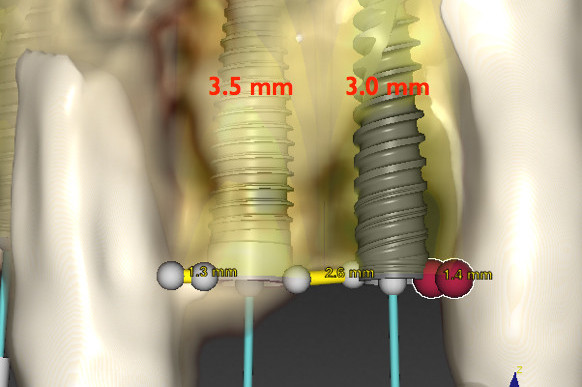Implant-prosthetic treatments are often only aimed at restoring lost or non-maintainable dental elements and can tend to overlook the patient’s general dental condition.
In this way the therapy becomes an end in itself and the final result will not satisfy the general condition of the patient both from an aesthetic and functional point of view. There is focus on the technical implementation of clinical procedures.
Successful implant therapy is characterized by careful prosthetic planning that takes into consideration not only aesthetics and function, but also “Timing”.
This is the sequence of all those clinical and technical procedural variables, fundamental to adequately manage the case, from the first provisional sample to the delivery of the final prosthesis.
The elements to be taken into consideration in planning an implant therapy derive from an in-depth analysis which is divided into three different moments: 1) Prosthetic analysis; 2) Anatomical analysis; 3) Surgical analysis.
In the treatment of partial Edentulia, prosthetic analysis (1) is necessary to evaluate the patient’s functional and occlusal condition, checking the potential integration of the restoration and, at the same time, taking into consideration the management of the temporary prosthesis.
Therefore it is important to determine whether specific therapy requires additional prosthetic and occlusal interventions or not.
Unlike the above, in the Edentule arches the advantage of being able to idealize the aesthetic and functional aspect can be made of use, treating the entire occlusal table with a reorganizing approach.
The occlusion represents the “context” within which our restorations will have to integrate, satisfying aesthetics and function: their maintainability and reliability over time are therefore closely related to the patient’s occlusal characteristics.
Determining the occlusal risk profile, having the possibility to control and manage it, represents a moment of substantial importance in the formulation of the treatment plan: the presence of an unfavorable occlusal and functional condition must be intercepted early and managed with the appropriate complex therapies, depending on severity and needs of the patient.
The Anatomical Analysis (2) takes into consideration the area to be treated and must take into account, in particular, the quality and quantity of the bone and soft tissues in relation to the waxing of the final prosthetic restoration.
The final objective will be to define the number, type and distribution of the implants to be positioned.
In this sense, the use of software dedicated for 3D planning today represents the gold standard in clinical practice.
This evaluation is closely related to the previous prosthetic analysis, in which all the prosthetic parameters with which you want to complete the therapy have been defined.
Finally, the Surgical Analysis (3) examines the technique and surgical times with which the implants will be positioned and consequently this phase will automatically depend on all previous evaluations.
Only in this way will implant therapy become the result of a correct prosthetic treatment plan, i.e. will take into account the patient’s health, needs, expectations and requests.

